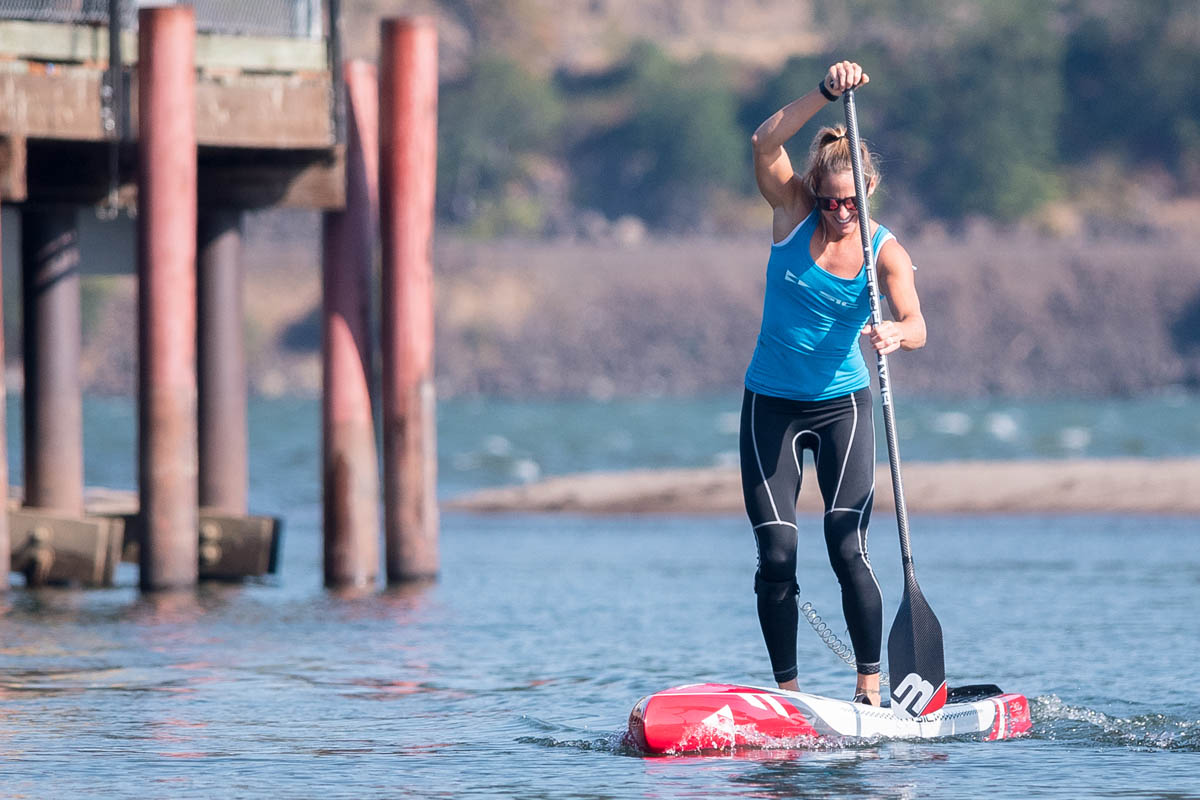How to Paddle Your SUP in a Straight Line & Improve Tracking
Fresh off wins at the both Battle of the Bay and Chattajack, Paddle Monster guru Seychelle Webster is back with more paddling tips as she prepares for the final stretch of her APP World Tour racing calendar.
Did you know that you can steer your board using the angle of your paddle shaft and blade? This is how the Tahitians steer their rudderless Va’a canoes.
Once mastered, this technique gives paddlers a huge advantage.
Otherwise, paddlers sacrifice speed by inadvertently using their paddle angle to steer the board from side-to-side. This leads to more switching sides, more distance traveled, and most importantly: slower average speeds.
Master the Vertical Stroke With Stacked Hands
In order to paddle in a straight line, think of your blade as a rudder. We want our paddle shaft to be completely vertical the moment our paddle enters the water. If the blade goes in at an angle, your stroke will be at an angle and your board won’t track straight. Failing to have a vertical shaft during the catch is one of the most common mistakes that paddlers make, but it can be easily fixed.
Proper vertical stroke form means that one hand is stacked directly on top of the other and both hands are just outside the edge of your board. You may notice that in order to achieve this position while standing, you’ll end up leaning awkwardly to one side which can create instability in the board.
In order to keep equal weight distribution and attain a vertical paddle stroke, we need to rotate our body during the stroke setup. Body rotation also increases your functional reach, which sets you up for a more powerful stroke. The wider the board, the more rotation is necessary to achieve this result.
Body Rotation While Paddling
Step 1: Soften your knees. Keeping your knees bent at all times while paddling is a must.
Step 2: Turn your chest away from your paddle, towards your non-paddle side.
Step 3: Drop your paddling side shoulder. To exaggerate this movement, your head can go between the A-frame of your outstretched arms.
Step 4: Rotate until both hands are outside the edge of the board and one hand is right on top of the other. You should feel a stretch through your non-paddle side body.
Try to make the rotation come from your thoracic spine (mid/upper back, rib cage vertebras). If your thoracic region feels tight, as is often the case for paddlers, it’s okay to let your hips rotate as well. For some paddlers, even rotating their paddling side knee, hip and shoulder forward works best.
How to Combat Rotation Imbalance
While there is debate about what is the ideal rotation technique, I’m of the mentality that there isn’t an exact right or wrong way to paddle/rotate. What works better for some folks won’t for work others, and vice-versa. However, if you’re dealing with spine tightness, try some of these mobility exercises.
Try that mobility exercise before your next paddle and if it helps, add it to your daily routine.
It’s very common for body rotation to feel easier on one side than it does on the other. This is caused by the fact that most of us are tighter on one side due to past injuries or simply because one side is more dominant.
Rotation imbalance is one of the main reasons why we feel stronger or paddle straighter on our dominant side. That’s why it’s so important to ensure you practice this rotation equally on both sides. Once you master this technique, I guarantee it’ll help you paddle straighter, for a longer period of time.
Correct SUP Fin Selection: Beginner vs. Advanced
If you’re still struggling with side-to-side paddling, your fin selection could be playing a major role in your struggles. For those still working on perfecting these techniques, it will help to use a fin with a larger surface area and wider base, like the RAY.
Eventually, you’ll find that you can easily paddle in a straight line and your race times will drop. At this point, you can graduate to a faster fin with a smaller surface area, like Black Project’s TIGER fin –– the same fin that won six World Titles at the 2019 ICF World Championships in China.
Need Help Choosing the Right Fin?
Check Out The Five Steps to Choosing A SUP Race Fin Guide
or
ASK A QUESTION
Fitness & Paddle Coaching from Seychelle
As an athlete and professional paddling coach, Seychelle offers a number of training options and advice via the Paddle Monster platform. If you are interested in having your stroke analyzed, working on a training program or arranging a clinic in your area, please get in touch with her via email. A number of Black Project athletes follow training programs designed by Seychelle.
Words: Seychelle
Photos: Sean Greeley, Jason Reinhart & Andrew Welker
Follow Seychelle on Instagram @seychelleSUP
Contact Seychelle For Paddle Coaching seychelle@paddlemonster.com
More Standup Paddling Resources
The Catch – Fixing the Most Important Part Of Your Paddle Stroke
The Five Phases of Proper SUP Stroke Technique
Compare Standup Paddle Race Fins
The SUP Racing Parent: A Mom Embracing Challenge With Rewards





